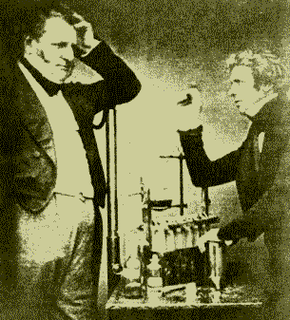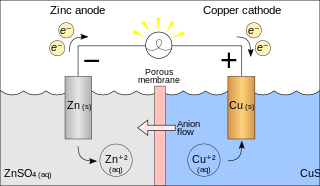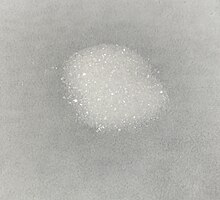
Electrochemistry is the branch of physical chemistry that studies the relationship between electricity, as a measurable and quantitative phenomenon, and identifiable chemical change, with either electricity considered an outcome of a particular chemical change or vice versa. These reactions involve electric charges moving between electrodes and an electrolyte. Thus electrochemistry deals with the interaction between electrical energy and chemical change.

The voltaic pile was the first electrical battery that could continuously provide an electric current to a circuit. It was invented by Italian physicist Alessandro Volta, who published his experiments in 1799. The voltaic pile then enabled a rapid series of other discoveries including the electrical decomposition (electrolysis) of water into oxygen and hydrogen by William Nicholson and Anthony Carlisle (1800) and the discovery or isolation of the chemical elements sodium (1807), potassium (1807), calcium (1808), boron (1808), barium (1808), strontium (1808), and magnesium (1808) by Humphry Davy.

A galvanic cell or voltaic cell, named after Luigi Galvani or Alessandro Volta, respectively, is an electrochemical cell that derives electrical energy from spontaneous redox reactions taking place within the cell. It generally consists of two different metals immersed in electrolytes, or of individual half-cells with different metals and their ions in solution connected by a salt bridge or separated by a porous membrane.
In electrochemistry, a half-cell is a structure that contains a conductive electrode and a surrounding conductive electrolyte separated by a naturally occurring Helmholtz double layer. Chemical reactions within this layer momentarily pump electric charges between the electrode and the electrolyte, resulting in a potential difference between the electrode and the electrolyte. The typical anode reaction involves a metal atom in the electrode dissolved and transported as a positive ion across the double layer, causing the electrolyte to acquire a net positive charge while the electrode acquires a net negative charge. The growing potential difference creates an intense electric field within the double layer, and the potential rises in value until the field halts the net charge-pumping reactions. This self-limiting action occurs almost instantly in an isolated half-cell; in applications two dissimilar half-cells are appropriately connected to constitute a Galvanic cell.

Cyclic voltammetry (CV) is a type of potentiodynamic electrochemical measurement. In a cyclic voltammetry experiment, the working electrode potential is ramped linearly versus time. Unlike in linear sweep voltammetry, after the set potential is reached in a CV experiment, the working electrode's potential is ramped in the opposite direction to return to the initial potential. These cycles of ramps in potential may be repeated as many times as needed. The current at the working electrode is plotted versus the applied voltage to give the cyclic voltammogram trace. Cyclic voltammetry is generally used to study the electrochemical properties of an analyte in solution or of a molecule that is adsorbed onto the electrode.

A counterion is the ion that accompanies an ionic species in order to maintain electric neutrality. In table salt (NaCl), the sodium ion is the counterion for the chlorine ion and vice versa.

Lithium perchlorate is the inorganic compound with the formula LiClO4. This white or colourless crystalline salt is noteworthy for its high solubility in many solvents. It exists both in anhydrous form and as a trihydrate.

A salt bridge, in electrochemistry, is a laboratory device used to connect the oxidation and reduction half-cells of a galvanic cell, a type of electrochemical cell. It maintains electrical neutrality within the internal circuit, preventing the cell from rapidly running its reaction to equilibrium. If no salt bridge were present, the solution in one half cell would accumulate negative charge and the solution in the other half cell would accumulate positive charge as the reaction proceeded, quickly preventing further reaction, and hence production of electricity.
In electrochemistry, overpotential is the potential difference (voltage) between a half-reaction's thermodynamically determined reduction potential and the potential at which the redox event is experimentally observed. The term is directly related to a cell's voltage efficiency. In an electrolytic cell the existence of overpotential implies the cell requires more energy than thermodynamically expected to drive a reaction. In a galvanic cell the existence of overpotential means less energy is recovered than thermodynamics predicts. In each case the extra/missing energy is lost as heat. The quantity of overpotential is specific to each cell design and varies across cells and operational conditions, even for the same reaction. Overpotential is experimentally determined by measuring the potential at which a given current density is achieved.

Lithium tetrafluoroborate is an inorganic compound with the formula LiBF4. It is a white crystalline powder. It has been extensively tested for use in commercial secondary batteries, an application that exploits its high solubility in nonpolar solvents.

Hexafluorophosphate is an anion with chemical formula of PF−
6. It is an octahedral species. It imparts no color to its salts. PF−
6 is isoelectronic with sulfur hexafluoride, SF6, and the hexafluorosilicate dianion, SiF2−
6, and fluoroantimonate SbF−
6. Being poorly nucleophilic, hexafluorophosphate is classified as a non-coordinating anion.

Lithium hexafluorophosphate is an inorganic compound with the formula LiPF6. It is a white crystalline powder. It is used in commercial secondary batteries, an application that exploits its high solubility in non aqueous, polar solvents. Specifically, solutions of lithium hexafluorophosphate in carbonate blends of ethylene carbonate, dimethyl carbonate, diethyl carbonate and/or ethyl methyl carbonate, with a small amount of one or many additives such as fluoroethylene carbonate and vinylene carbonate, serve as state-of-the-art electrolytes in lithium-ion batteries. This application also exploits the inertness of the hexafluorophosphate anion toward strong reducing agents, such as lithium metal.

Sodium hexafluorophosphate is an inorganic compound with the chemical formula Na[PF6].

Lithium tetrachloroaluminate (LAC, lithium aluminium chloride) is an inorganic compound, a tetrachloroaluminate of lithium, with the formula LiAlCl4.
In electrochemistry, ITIES is an electrochemical interface that is either polarisable or polarised. An ITIES is polarisable if one can change the Galvani potential difference, or in other words the difference of inner potentials between the two adjacent phases, without noticeably changing the chemical composition of the respective phases. An ITIES system is polarised if the distribution of the different charges and redox species between the two phases determines the Galvani potential difference.

Ferrocenium tetrafluoroborate is an organometallic compound with the formula [Fe(C5H5)2]BF4. This salt is composed of the cation [Fe(C5H5)2]+ and the tetrafluoroborate anion (BF−
4). The related hexafluorophosphate is also a popular reagent with similar properties. The cation is often abbreviated Fc+ or Cp2Fe+. The salt is deep blue in color and paramagnetic. Ferrocenium salts are sometimes used as one-electron oxidizing agents, and the reduced product, ferrocene, is inert and readily separated from ionic products. The ferrocene–ferrocenium couple is often used as a reference in electrochemistry. The standard potential of ferrocene-ferrocenium is 0.400 V vs. the normal hydrogen electrode (NHE) and is often assumed to be invariant between different solvents.
Ferrocenium hexafluorophosphate is an organometallic compound with the formula [Fe(C5H5)2]PF6. This salt is composed of the cation [Fe(C5H5)2]+ and the hexafluorophosphate anion (PF−
6). The related tetrafluoroborate is also a popular reagent with similar properties. The cation is often abbreviated Fc+ or Cp2Fe+. The salt is deep blue in color and paramagnetic.
A supporting electrolyte, in electrochemistry, according to an IUPAC definition, is an electrolyte containing chemical species that are not electroactive and which has an ionic strength and conductivity much larger than those due to the electroactive species added to the electrolyte. Supporting electrolyte is also sometimes referred to as inert electrolyte or inactive electrolyte.
Tetrabutylammonium is a quaternary ammonium cation with the formula [N(C4H9)4]+. It is used in the research laboratory to prepare lipophilic salts of inorganic anions. Relative to tetraethylammonium derivatives, tetrabutylammonium salts are more lipophilic but crystallize less readily.

Lithium bis(trifluoromethanesulfonyl)imide, often simply referred to as LiTFSI, is a hydrophilic salt with the chemical formula LiC2F6NO4S2. It is commonly used as Li-ion source in electrolytes for Li-ion batteries as a safer alternative to commonly used lithium hexafluorophosphate. It is made up of one Li cation and a bistriflimide anion.















